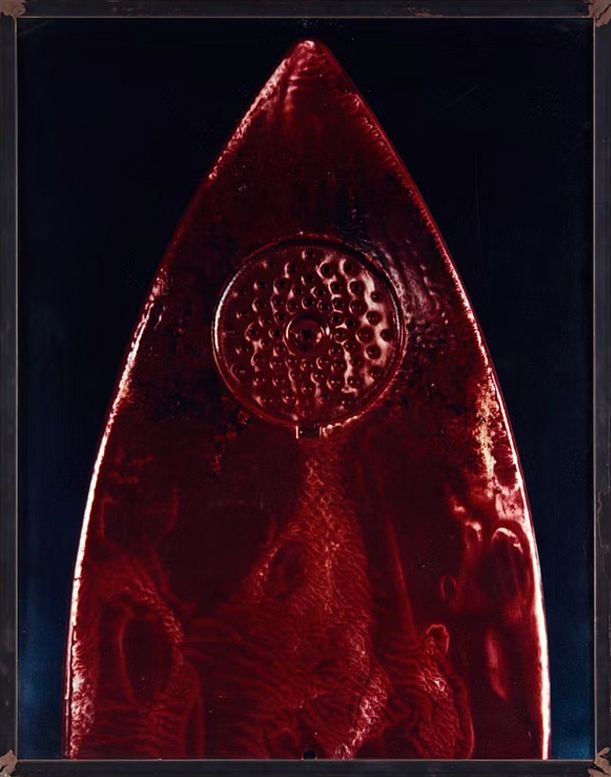Tuija Lindström
Iron, from the series The Girls at Bull’s pond
, 1992Iron comes from the series Kvinnorna vid Tjursjön (The Girls at Bulls Pond) which consists of twelve photographs of floating women in different positions and an equal number of photographs depicting domestic irons, about half of which are red. Iron was exhibited in Tuija Lindström’s celebrated solo exhibition Look at Us at Liljevalchs konsthall (Liljevalch’s Public Art Gallery) in Stockholm 2004. The curator of the exhibition, Niclas Östlind, wrote the following about Iron , and the series The Girls at Bulls Pond, in the exhibition catalogue:
In Kvinnorna vid Tjursjön (The Girls at Bulls Pond) (1991-1992) white bodies float in dark water. Their corporeality is prominent in spite of the fact that they seem to be in a state of weightlessness. The women -one to each picture- have assumed different poses and there is something ritually archaic about their actions: one is lying with her arms stretched out as though crucified, another has her hands behind her back as though they were tied there, a third has assumed a foetal posture and a fourth is kneeling with her head pointing downwards beneath the surface of the water. An undercurrent of both voluptuousness and morality seeks its way up to the surface of this calm forest pond. Taken together, the variations in position taken up by the women constitute a testing of different ways of being; in the deepest sense it can be seen as a search for identity. It is probably the women’s integrity which ensures that-despite their nakedness-they cannot be objectified in a simple way. This consciousness of self also causes them to offer resistance to the limiting idea about woman’s closeness to nature-even when they are shown in what is the origin of all life: water. The complex character of the pictures of floating women is emphasised by the meeting with the second part of the work, which is a series of photographs of spiky, metallic objects. Both in shape and as signs they are notably phallic; and several critics have pointed to their similarity with death-bringing projectiles and cathedrals striving upwards. Yet, interestingly enough, they portray an object which traditionally belongs to the everyday female sphere: the domestic iron. It is their hot smooth undersides that are shown and the aggressive monumentality has more to do with the appearance of the subject than the fact that they are larger than the other pictures. The confrontation with the soft flesh of the unprotected bodies heightens the threatening character of these pictures. Half of the irons are also mottled red and the membrane -now thick, now thin- is reminiscent of clotted blood. The surfaces are open wounds. It is not difficult to imagine what may have happened. For many women home is a danger zone, a crime scene. When the work was first shown, war was raging in the Balkans and consciousness of gang-rapes and other abuse created a dark sounding board for interpreting the suite. Shown together, the women and the domestic irons form a cluster of conceptions and experiences that give rise to more questions than they supply straightforward answers.
A few years before Östlind’s text was published in the exhibition catalogue, Ann-Charlotte Glasberg, who later became an art critic, interpreted the work as a questioning of a pre-ordained feminine identity and a testing of different roles, in her undergraduate thesis entitled Tuija Lindströms bildsvit “Kvinnorna vid Tjursjön” - ett sökande efter identitet (Department of Art History, University of Gothenburg, Sweden, 1995). Her psychoanalytically oriented feminist reading of Lindström’s work also points out the complexity of the work with regard to the question of power. The iron is a ‘feminine’ object that Glasberg claims is similar in shape to a woman’s pudenda. Half of the irons are blood-red and their wounded state is an expression of loss - in this case the lack of a phallus (power). But it is not a question of a simple state of opposites in which the man has power and the woman is a victim. The problem is that the woman has internalized the phallocentric order (the father’s law) and has thereby become part of the power that sustains the patriarchal order: both the man and the woman limit and subordinate women.
Signed and dated (verso) ’Tuija Lindström 1992’.
Edition 5.
Image 106.5 x 82.5 cm. Including original iron picture frame 112 x 89 cm.
Provenance
Private collection.
Bukowskis, Stockholm, sale 533 Moderna + Contemporary & Design,3 November 2004, lot 500.
Private collection (acquired at the sale above).
Stockholms Auktionsverk, Stockholm, Nutida och fotografi, 13 November 2012, lot 122.
Stockholms Auktionsverk, Stockholm, Design - Nutida konst, 11 May 2015, lot 1181.
Private collection, Stockholm.
Bukowskis, Stockholm, sale 599, Contemporary, 16 May 2017, lot 125.
Private collection, Sweden.
Firestorm Foundation.
Exhibitions
Galleri Index, Stockholm, 1992.
Liljevalchs konsthall (Liljevalchs Public Art Gallery), Stockholm, Tuija Lindström. Look at Us, 5 June - 22 August 2004, no. 76.
Literature
Bo Nilsson, Niclas Östlind & Tuija Lindström, Tuija Lindström. Look at Us, 2004, illustrated full page in colour, fig. 76.
Copyright Firestorm Foundation
